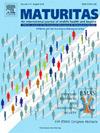Diabetes is associated with impaired skeletal muscle quality, not quantity, in older adults, based on CT-derived chest muscle metrics
IF 3.6
2区 医学
Q2 GERIATRICS & GERONTOLOGY
引用次数: 0
Abstract
Objective
The study assessed the association between diabetes and both the quantity and quality of skeletal muscle among older adults, based on an analysis of chest computed tomography (CT) scans.
Methods
In this cross-sectional study of 1225 adults aged 65 years or more, 255 had type 2 diabetes mellitus. All participants had chest CT scans. Skeletal muscle index and skeletal muscle density at the level of the fourth thoracic vertebra were assessed using SliceOmatic software.
Results
Skeletal muscle density at the fourth thoracic level was significantly lower in the diabetes group, while no significant difference between groups was observed in the muscle index. Spearman correlation analysis showed no significant correlation between fasting plasma glucose or glycated hemoglobin and the muscle index. However, both fasting plasma glucose and glycated hemoglobin were negatively correlated with skeletal muscle density (rho = −0.100 and −0.194, respectively; both P < 0.05). After adjusting for potential confounders, linear regression analysis indicated that diabetes was negatively associated with skeletal muscle density (β = −0.069, P = 0.002). Logistic regression analysis identified skeletal muscle density as a significant independent factor associated with diabetes (OR = 0.943, 95 % confidence interval 0.908–0.979, P = 0.002).
Conclusion
Based on chest CT scan, diabetes exerts a discernible impact on the quality of skeletal muscle (skeletal muscle density) at the fourth thoracic level among older adults, rather than its quantity (skeletal muscle index). These insights can inform clinical interventions and disease management strategies.
基于ct衍生的胸肌指标,糖尿病与老年人骨骼肌质量受损有关,而不是与数量受损有关
目的:本研究通过对胸部CT扫描的分析,评估糖尿病与老年人骨骼肌数量和质量之间的关系。方法对1225名65岁以上的成年人进行横断面研究,其中255人患有2型糖尿病。所有参与者都进行了胸部CT扫描。采用SliceOmatic软件评估骨骼肌指数和第四胸椎水平骨骼肌密度。结果糖尿病组第4胸段骨骼肌密度明显降低,肌肉指数组间差异无统计学意义。Spearman相关分析显示空腹血糖或糖化血红蛋白与肌肉指数无显著相关性。然而,空腹血糖和糖化血红蛋白与骨骼肌密度呈负相关(rho分别= - 0.100和- 0.194,P均为0.05)。在校正潜在混杂因素后,线性回归分析显示糖尿病与骨骼肌密度呈负相关(β = - 0.069, P = 0.002)。Logistic回归分析发现骨骼肌密度是与糖尿病相关的重要独立因素(OR = 0.943, 95%可信区间0.908 ~ 0.979,P = 0.002)。结论基于胸部CT扫描,糖尿病对老年人第4胸段骨骼肌质量(骨骼肌密度)的影响明显,而对骨骼肌数量(骨骼肌指数)的影响较小。这些见解可以为临床干预和疾病管理策略提供信息。
本文章由计算机程序翻译,如有差异,请以英文原文为准。
求助全文
约1分钟内获得全文
求助全文
来源期刊

Maturitas
医学-妇产科学
CiteScore
9.10
自引率
2.00%
发文量
142
审稿时长
40 days
期刊介绍:
Maturitas is an international multidisciplinary peer reviewed scientific journal of midlife health and beyond publishing original research, reviews, consensus statements and guidelines, and mini-reviews. The journal provides a forum for all aspects of postreproductive health in both genders ranging from basic science to health and social care.
Topic areas include:• Aging• Alternative and Complementary medicines• Arthritis and Bone Health• Cancer• Cardiovascular Health• Cognitive and Physical Functioning• Epidemiology, health and social care• Gynecology/ Reproductive Endocrinology• Nutrition/ Obesity Diabetes/ Metabolic Syndrome• Menopause, Ovarian Aging• Mental Health• Pharmacology• Sexuality• Quality of Life
 求助内容:
求助内容: 应助结果提醒方式:
应助结果提醒方式:


